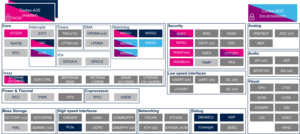1. Article purpose[edit source]
The purpose of this article is to:
- briefly introduce the VDERAM internal memory peripheral and its main features,
- indicate the peripheral instances assignment at boot time and their assignment at runtime (including whether instances can be allocated to secure contexts),
- list the software frameworks and drivers managing the peripheral,
- explain how to configure the peripheral.
2. Peripheral overview[edit source]
The VDERAM peripheral is 128-Kbyte wide and physically near to the video decoder and to the video encoder for optimized performances from the engines.
By default, this memory is exclusively assigned to video encoder and decoder engines (Configuration is done in SYSCFG by the main processor. In that case it is not accessible by the rest of the system.
When both video encoder and video decoder are not used, it is possible to allocated this memory to the rest of the system.
In that case, VDERAM is protected via a RISAB memory firewall allowing to define 4-Kbyte granularity regions with different access rights. Each region could be assigned to different execution contexts. VDERAM also owns automatic clock gating (for power management optimization) which can be linked:
- either on one processor low power state if bank is only assigned to this processor
- or on system low power state if bank is assigned to several processors
VDERAM content is preserved in (LPLV)Stop1/2 low power mode but it is lost in Standby low power mode as not supplied.
Refer to the STM32 MPU reference manuals for the complete list of features, and to the software frameworks and drivers, introduced below, to see which features are implemented.
3. Peripheral usage[edit source]
This chapter is applicable in the scope of the OpenSTLinux BSP running on the Arm® Cortex®-A processor(s), and the STM32CubeMPU Package running on the Arm® Cortex®-M processor.
3.1. Boot time assignment[edit source]
3.1.1. On STM32MP2 series[edit source]
VDERAM is not used at boot time and during low power exit sequence. Bootloaders simplify don't know about VDERAM product assignment between video encoder and video decoder and rest of the system.
Click on ![]() to expand or collapse the legend...
to expand or collapse the legend...
- ☐ means that the peripheral can be assigned to the given boot time context.
- ☑ means that the peripheral is assigned by default to the given boot time context and that the peripheral is mandatory for the STM32 MPU Embedded Software distribution.
- ⬚ means that the peripheral can be assigned to the given boot time context, but this configuration is not supported in STM32 MPU Embedded Software distribution.
- ✓ is used for system peripherals that cannot be unchecked because they are hardware connected in the device.
The present chapter describes STMicroelectronics recommendations or choice of implementation. Additional possibilities might be described in STM32MP25 reference manuals.
| Domain | Peripheral | Boot time allocation | Comment | |||
|---|---|---|---|---|---|---|
| Instance | Cortex-A35 secure (ROM code) |
Cortex-A35 secure (TF-A BL2) |
Cortex-A35 non-secure (U-Boot) | |||
| Core/RAM | VDERAM | VDERAM | ☐ | ☐ | ||
3.2. Runtime assignment[edit source]
In STM32MPU Embedded Software, when video encoder and video decoder are available depending on part number, they are activated by default to demonstrate the platform capabilities. When video encoder and video decoder are not available, VDERAM is free for the rest of the system.
3.2.1. On STM32MP25x lines  [edit source]
[edit source]
Click on ![]() to expand or collapse the legend...
to expand or collapse the legend...
Check boxes illustrate the possible peripheral allocations supported by STM32 MPU Embedded Software:
- ☐ means that the peripheral can be assigned to the given runtime context.
- ☑ means that the peripheral is assigned by default to the given runtime context and that the peripheral is mandatory for the STM32 MPU Embedded Software distribution.
- ⬚ means that the peripheral can be assigned to the given runtime context, but this configuration is not supported in STM32 MPU Embedded Software distribution.
- ✓ is used for system peripherals that cannot be unchecked because they are hardware connected in the device.
The present chapter describes STMicroelectronics recommendations or choice of implementation. Additional possibilities might be described in STM32MP25 reference manuals.
| Domain | Peripheral | Runtime allocation | Comment | |||||
|---|---|---|---|---|---|---|---|---|
| Instance | Cortex-A35 secure (OP-TEE / TF-A BL31) |
Cortex-A35 non-secure (Linux) |
Cortex-M33 secure (TF-M) |
Cortex-M33 non-secure (STM32Cube) |
Cortex-M0+ (STM32Cube) | |||
| Core/RAM | VDERAM | VDERAM | ☐OP-TEE
☐BL31 |
☐ | ☐ | ☐ | Free for any use if video encoder and video decoder not used. | |
4. Software frameworks and drivers[edit source]
Below are listed the software frameworks and drivers using the VDERAM peripheral for the embedded software components listed in the above tables.
- Linux®: reserved memory, that is used by the dmaengine (for DMA buffers management) or RPMsg for interprocess communication with the coprocessor
- OP-TEE: OP-TEE
- STM32Cube: STM32Cube
The default assignment set in STMicroelectronics distribution is in line with the platform memory mapping, that can be adapted by the platform user.
5. How to assign and configure the peripheral[edit source]
The peripheral assignment can be done via the STM32CubeMX graphical tool (and manually completed if needed).
This tool also helps to configure the peripheral:
- partial device trees (pin control and clock tree) generation for the OpenSTLinux software components,
- HAL initialization code generation for the STM32CubeMPU Package.
The configuration is applied by the firmware running in the context in which the peripheral is assigned.
